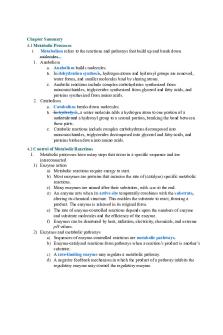Cellular Metabolism Review PDF

| Title | Cellular Metabolism Review |
|---|---|
| Course | Principles Of Biology I |
| Institution | University of Georgia |
| Pages | 3 |
| File Size | 195.4 KB |
| File Type | |
| Total Downloads | 96 |
| Total Views | 144 |
Summary
BIOL 1107
Cellular Metabolism Review...
Description
Cellular Metabolism Review Sheet Metabolism- totality of chemical reactions within a cell/organism Metabolic Pathways: A series of chemical reactions that either builds a complex molecule or breaks down a complex molecule into simpler compounds
Catabolism
fuels for
Large molecules are broken down energy released (Exergonic Reaction)
Ex: cellular respiration
Energy
Anabolism
Small molecules are assembled into larger ones energy required (Endergonic Reaction)
Ex: DNA replication, photosynthesis, protein synthesis
ATP(Adenosine Triphosphate)-
-ability to do work, - Immediate source of energy to power cellular work catalyze reactions, and - type of nucleotide- consists of nitrogenous base adenine, the fight entropy (randomness) sugar ribose, and a chain of 3 phosphate groups -Molecules possess energy -releases free energy when phosphate bonds are broken down because of arrangement -u sed to drive endergonic reactions in cells of their atoms Bioenergetics: study of how organisms manage their energy resources Thermodynamics: the study of energy transformations Closed system- energy and matter isolated from surroundings Open System- energy and matter can be transferred between the system and its surroundings. -Organisms are open systems- They absorb energy—light or chemical energy in the form of organic molecules—and release heat and metabolic waste products such as urea or CO2 to their surroundings
Kinetic Energy Relative motion of objects eat or thermal energy H
Potential Energy Energy that matter possesses due to location or structure chemical energy-stored in molecules due to arrangement of atoms.
First Law of Thermodynamics
-energy can be transferred and transformed, but
Second Law of Thermodynamics -every energy transfer or transformation increases
cannot be created or destroyed Aka Principle of Conservation of Energy
○ ○
entropy of the universe
Free Energy- System energy for work: ∆G Positive ∆G : energy absorbing/ taking/ anabolic (Endergonic) Negative ∆G : energy releasing/ giving/ catabolic (Exergonic)
Energy Coupling- the use of an exergonic process to drive an endergonic one -Endergonic + exergonic = -∆G Phosphorylation-
- addition of phosphate to ADP to
Hydrolysis- - ATP bonds between phosphate groups can be broken by hydrolysis
form ATP
Enzymes
- unstable: hydrolysis yields energy (Biological Catalysts) because products are more stable -chemical agent- selectively increases rate of - regulate metabolic pathways reaction without being consumed by reaction - Release of energy during the - speed up or inhibit processes hydrolysis of ATP comes from -enzyme and substrate bind and change shapechemical change to a state of put stress on molecule -> needing less E to break lower free energy, not from phosphate -Active site (w here enzyme binds to protein or bonds other substance during reaction)= region substrate induced fit model (Lock & Key) Effects on Enzyme Activity: -Temperature & pH -Cofactor nonprotein molecule Required for proper functioning of an enzyme Coenzyme- organic molecule serving as a cofactor
Enzyme Inhibitors
Reversible Allosteric regulation
binding of a regulatory molecule to a protein at 1 site that affects the
v s.
-Hydrogen Bond
Competitive
Irreversible -Covalent Bond
vs.
- blocks Activation Site
Noncompetitive - Shuts down enzyme
Activation Energy
function at a different site
- energy needed to push reactants over energy barrier so that reaction can proceed...
Similar Free PDFs

Cellular Metabolism Review
- 3 Pages

Chapter 4: Cellular Metabolism
- 2 Pages

A&P 1 Ch.4 Cellular Metabolism
- 4 Pages

Cellular Transport Review 21
- 6 Pages

Glycogen metabolism
- 20 Pages

Nutrition & Metabolism
- 19 Pages

Energy Metabolism
- 9 Pages

metabolism mind map
- 1 Pages

Cellular Communications
- 1,036 Pages

Chapter 5 - Microbial Metabolism
- 8 Pages

Metabolism - Key Steps
- 5 Pages
Popular Institutions
- Tinajero National High School - Annex
- Politeknik Caltex Riau
- Yokohama City University
- SGT University
- University of Al-Qadisiyah
- Divine Word College of Vigan
- Techniek College Rotterdam
- Universidade de Santiago
- Universiti Teknologi MARA Cawangan Johor Kampus Pasir Gudang
- Poltekkes Kemenkes Yogyakarta
- Baguio City National High School
- Colegio san marcos
- preparatoria uno
- Centro de Bachillerato Tecnológico Industrial y de Servicios No. 107
- Dalian Maritime University
- Quang Trung Secondary School
- Colegio Tecnológico en Informática
- Corporación Regional de Educación Superior
- Grupo CEDVA
- Dar Al Uloom University
- Centro de Estudios Preuniversitarios de la Universidad Nacional de Ingeniería
- 上智大学
- Aakash International School, Nuna Majara
- San Felipe Neri Catholic School
- Kang Chiao International School - New Taipei City
- Misamis Occidental National High School
- Institución Educativa Escuela Normal Juan Ladrilleros
- Kolehiyo ng Pantukan
- Batanes State College
- Instituto Continental
- Sekolah Menengah Kejuruan Kesehatan Kaltara (Tarakan)
- Colegio de La Inmaculada Concepcion - Cebu




